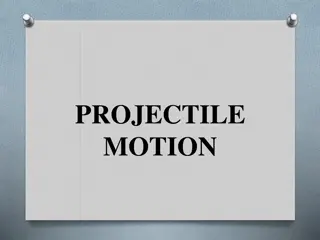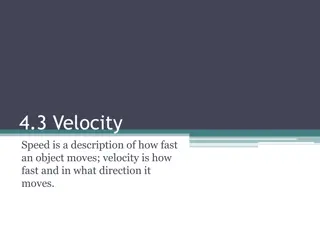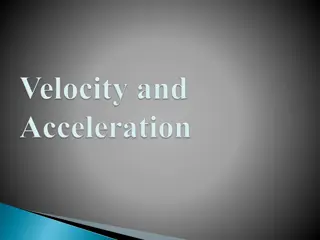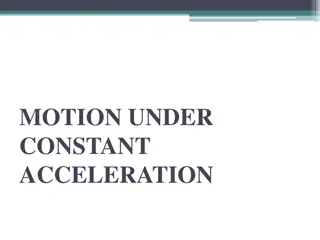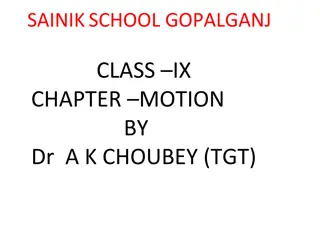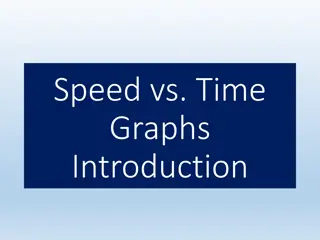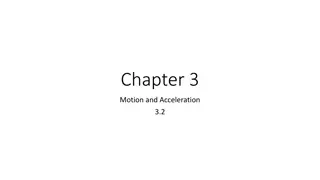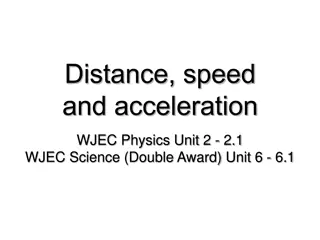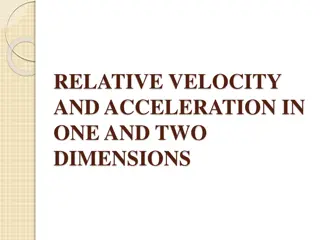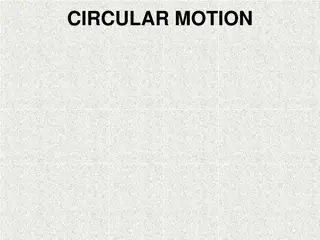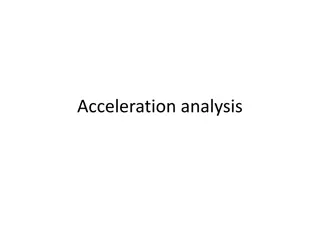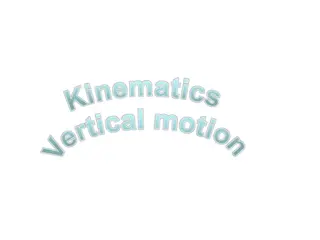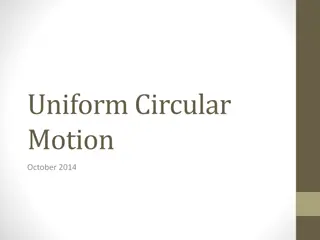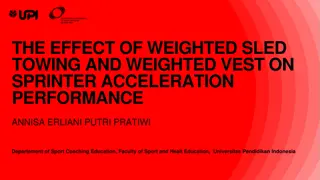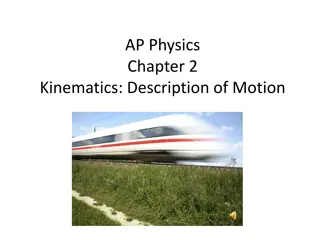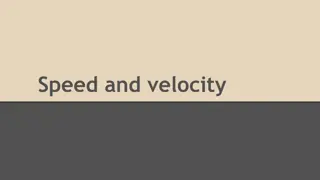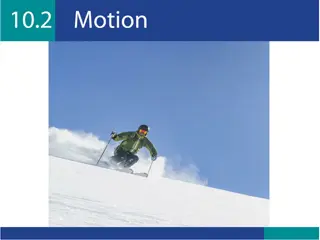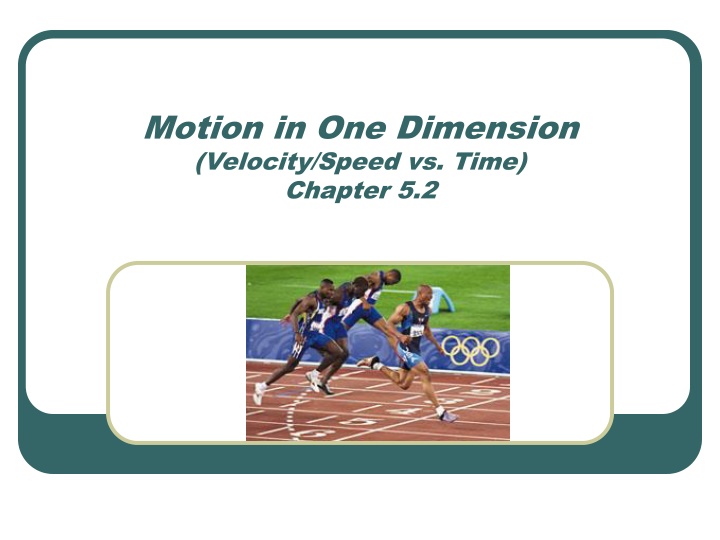
Velocity and Acceleration in One-Dimensional Motion
Explore the concepts of instantaneous speed, the impact of speed on displacement, significance of slopes in velocity vs. time graphs, and how acceleration is determined from curves. Learn how to calculate displacement from velocity graphs and interpret acceleration values.
Download Presentation

Please find below an Image/Link to download the presentation.
The content on the website is provided AS IS for your information and personal use only. It may not be sold, licensed, or shared on other websites without obtaining consent from the author. If you encounter any issues during the download, it is possible that the publisher has removed the file from their server.
You are allowed to download the files provided on this website for personal or commercial use, subject to the condition that they are used lawfully. All files are the property of their respective owners.
The content on the website is provided AS IS for your information and personal use only. It may not be sold, licensed, or shared on other websites without obtaining consent from the author.
E N D
Presentation Transcript
Motion in One Dimension (Velocity/Speed vs. Time) Chapter 5.2
What is instantaneous speed? 100M Sprint Final Split times and instantaneous speeds in 10 m intervals World Championships; Athens, Greece; 1997 Maurice Greene Donovan Bailey distance (m) 0 10 20 30 40 50 60 70 80 90 100 time (s) 0 1.71 2.75 3.67 4.55 5.42 6.27 7.12 7.98 8.85 9.73 speed (m/s) 0 8.71 10.47 11.14 11.5 11.67 11.8 11.68 11.57 11.51 11.3 time (s) 0 1.78 2.81 3.72 4.59 5.44 6.29 7.14 8 8.87 9.77 speed (m/s) 0 8.9 10.55 11.28 11.63 11.76 11.8 11.7 11.55 11.38 11
What effect does an increase in speed have on displacement? d6 d5 d4 d3 d2 d1
Instead of position vs. time, consider velocity or speed vs. time. Relatively constant speed = no acceleration High acceleration
What is the significance of the slope of the velocity/speed vs. time curve? Since velocity is on the y-axis and time is on the x-axis, it follows that the slope of the line would be: = y v = Slope x t Therefore, slope must equal acceleration. Velocity Time
What information does the slope of the velocity vs. time curve provide? A. Positively sloped curve = increasing velocity (Speeding up). B. Negatively sloped curve = decreasing velocity (Slowing down). C. Horizontally sloped curve = constant velocity. Velocity Velocity Velocity Velocity Velocity Velocity Time Time Time Zero Acceleration Negative Acceleration Positive Acceleration A B C
Acceleration determined from the slope of the curve. What is the acceleration from t = 0 to t = 1.71 seconds? ????? =???? ??? ?=?? ?? ?? ?? ? = ? ? =8.71?/? 0.00?/? 1.71? 0.00? ? = 5.09 ?/?2 ????? ? = ?: ? = 5.09 ?/?2
How can displacement be determined from a velocity vs. time graph? Measure the area under the curve. d = v*t Where t is the x component v is the y component A1 = d1 = v1* t1 Velocity A2 = d2 = v2* t2 A2 A1 dtotal = d1 + d2 Time
Measuring displacement from a velocity vs. time graph. A = b x h A = (7.37s)(11.7m/s) A = 86.2 m A = b x h A = (2.36s)(11.7m/s) A = 13.8 m
Example #1 The graph below shows the relationship between velocity and time for a car traveling in a straight line. Determine the acceleration during the first 4 seconds of travel. Determine the acceleration during the last 4 seconds of travel. Determine the overall acceleration for the full 8 seconds of travel. Determine the displacement from 0 - 8 seconds. 25 20 Velocity (m/s) 15 10 5 0 0 1 2 3 4 5 6 7 8 Time (s)
Example #1(Cont.): Acceleration from 0 4 seconds: ? = ? (4 ? 0 ?) ?=(20? ? 0? ?) ? =1 2 ? =1 2 1 s 5? = 2.5 m ? ? = 5 ?/?2 25 Acceleration from 4 8 seconds: ? = ? (8 ? 4 ?) 20 ?=(0? ? 20? ?) 2.5m 2.5m Velocity (m/s) 15 5m 5m 2.5m 2.5m ? = 5 ?/?2 10 5m 5m 5m 5m 2.5m 2.5m 5 Acceleration from 0 8 seconds: ? = ? (8 ? 0 ?) 5m 5m 5m 5m 5m 5m 2.5m 2.5m ?=(0? ? 0? ?) 0 0 1 2 3 4 5 6 7 8 Time (s) ? = 0 1 s 5? ? = ? = = 5 m ? Displacement from 0 8 seconds: ? =1 2 ? =1 2 (8 s)(20? ?) ? = 12 5 m + 8 2.5 m = 80 m ? = 80 ?
Example #2: What would the position vs. time curve look like for the automobile? 25 90 80 20 70 Displacement (m) 60 Velocity (m/s) 15 50 40 10 30 20 5 10 0 0 0 1 2 3 4 5 6 7 8 0 1 2 3 4 5 6 7 8 9 Time (s) Time (s) Remember, the slope of the displacement vs. time curve equals velocity.
Algebraically deriving the kinematics formulas in your reference table
Determining velocity from acceleration If acceleration is considered constant or uniform: ?=?? ?? ?? ?? Since ti is normally set to 0, this term can be eliminated. Rearranging terms to solve for vf results in: ?? = ?? + ?? ? ? = Velocity Velocity Time
What is the average velocity? If the total displacement and time are known, the average velocity can be found using the formula: ? ? ? = However, if all you have are the initial and final velocities, the average value can be found by: ??+?? 2 ?? ???? Velocity Velocity ? = ?? This latter formula is not in your reference table! Time
Example #1: Finding the average acceleration and velocity An automobile accelerates uniformly from 15 m/s to 25 m/s in 5.0 seconds. What is the acceleration of the automobile? What is the average speed of the automobile during this transition? ? ?=25?/? 15?/? =10?/? 5.0? ? = 5.0? ??= 25?/? ? = 2.0? Velocity ???? Velocity ?2 ??+ ?? 2 =15?/? + 25?/? ??= 15?/? ? = 2 Time ? = 20.?/?
How to determine position, velocity or acceleration without time. ??= ?? + (?? + ??) ? (1) + ( ) v v f i = v avg ?? = ?? + ?? 2 (2) ? ? Solve (2) for t: ? = Remember, since ? = ? = ?? (?? ??) ? and substitute back into (1) (??+ ??)(?? ??) ? By rearranging to solve for ??2 : ?? ?? = ??2 ??2 ?? = ?? + Note that ??+ ?? ??2 = ??2 + 2? (?? ??) (3) d
How to determine displacement, time or How to determine displacement, time or initial velocity without the final velocity. initial velocity without the final velocity. ? = (?? + ??) ? (1) ?? = ??+ ?? Substitute (2) into (1) for vf ? = (?? + ?? + ??) ? ? = ??? + ??2 (2) (4)
Formulas for Motion of Objects Equations to use when an accelerating object has an initial velocity. Form to use when accelerating object starts from rest (vi = 0). ? = (??+ ??)? ? = ??? ?? = ??+ ?? ??= ?? ? = ??2 ? = ??? + ??2 ??2 = ??2+ 2? ? ??2 = 2? ?
Example 2: Calculating Distance You are driving your automobile to grandma s house when you need to enter a highway. You are initially traveling at 15.0 m/s on an entrance ramp at which point you accelerate at 2.00 m/s2 for 5.00 seconds while merging into traffic. How far has your vehicle traveled during the acceleration? What is your final speed once you merge onto the highway Data d a vf vi t ? 2.00 m/s2 ? 15 m/s 5.00 s
Example 2: Calculating Distance From your reference table: Note that the only unknown if we use this equation is the distance. ? = 15.0? ? ? = 100 ? ? = ??? + ??2 5.00? + (2.00? ?2) 5.00?2
Example 2: Calculating Final Speed From your reference table: In this case the only unknown will be the final velocity. ??= ??? + ?t ??= 15.0? 5.00? + (2.00? ?2) 5.00? ? ??= 25 ?/?
Example 3: Calculating Distance A little while later, you need to slam on your brakes due to a slow down entering a construction zone. You were initially traveling at 25.0 m/s and during braking, your acceleration was -5.00 m/s2 over a distance of 60.0 meters. What was your final speed? How long did it take you to slow down ignoring your reaction time? Data 60.0 m -5.00 m/s2 ? 25 m/s ? d a vf vi t
Example 3: Calculating the final speed. From your reference table: ??2= ??2+ 2? ? Note that the only unknown if we use this equation is the final speed. Since you are slowing down, treat the acceleration as a negative value. ??= 25.0? ? ??= 5 ?/? 2 2(5.00? ?2) 60 ?
Example 3: Calculating the time. From your reference table: ??= ??+ ?? Time is the only unknown in this equation. With a little bit of algebraic rearrangement we get ? =?? ?? ? 2 25.0? ? 5.00? 5.00? ?2 ? = 4 ? ?
1D Motion in the Vertical Direction and Acceleration due to Gravity
Acceleration due to Gravity All falling bodies accelerate at the same rate when the effects of friction due to water, air, etc. can be ignored. Acceleration due to gravity is caused by the influences of Earth s gravity on objects. The acceleration due to gravity is given the special symbol g. The acceleration of gravity is a constant close to the surface of the earth. g = -9.81 m/s2
Example 3: Calculating Distance A stone is dropped from the top of a tall building. After 3.00 seconds of free-fall, what is the displacement, y of the stone? Data ? y -9.81 m/s2 a = g n/a vf vi t 0 m/s 3.00 s
Example 3: Calculating Distance From your reference table: Since vi = 0 we will substitute g for a and y for d to get: ? = ??2 ? = 9.81? ? = ??? + ??2 3.00?2 ?2 ? = 44.1 ?
Example 4: Calculating Final Velocity What will the final velocity of the stone be? Data -44.1 m y -9.81 m/s2 a = g ? vf vi t 0 m/s 3.00 s
Example 4: Calculating Final Velocity Using your reference table: ??= ??+ ?? Again, since vi = 0 and substituting g for a, we get: ??= ?? ?? = ( 9.81 ?/?2)(3.00 ?) ??= 29.4 ?/? Or, we can also solve the problem with: ??2= ??2+ 2? ?,? ??? ??= 0, ? = ? and ? = ? ?? = ??= 2( 9.81?/?2)( 44.1? ? = 29.4 ?/? 2??
Example 5: Determining the Maximum Height How high will the coin go? Data ? y -9.81 m/s2 a = g 0 m/s vf vi t 5.00 m/s ?
Example 4: Determining the Maximum Height Since we know the initial and final velocity as well as the rate of acceleration we can use: ??2= ??2+ 2? ? Since d = y we can algebraically rearrange the terms to solve for y. 2 ? = ?? 2? ? =( 5.00?/?)2 2( 9.81? = 1.27? ?2)
Example 6: Determining the Total Time in the Air How long will the coin be in the air? Data 1.27 m y -9.81 m/s2 a = g 0 m/s vf vi t 5.00 m/s ?
Example 6: Determining the Total Time in the Air Since we know the initial and final velocity as well as the rate of acceleration we can use: ??= ??+ ? ?, where ? = ? Solving for t gives us: v t g 0 / 5 / 9.81 / m s v f i = m s m s = = 0.510 t s 2 Since the coin travels both up and down, this value must be doubled to get a total time of 1.02s
Key Ideas Instantaneous velocity is equal to the slope of a line tangent to a position vs. time graph. Slope of a velocity vs. time graphs provides an objects acceleration. The area under the curve of a velocity vs. time graph provides the objects displacement. Acceleration due to gravity is the same for all objects when the effects of friction due to wind, water, etc can be ignored.
Important equations to know for uniform acceleration. df = di + (vi + vf)*t df = di + vit + at2 vf2 = vi2 + 2a*(df di) vf = vi +at a = v/ t = (vf vi)/(tf ti)
Determining instantaneous velocity 1997 World Championships - Athens, Greece Maurice Green 100 90 80 y = 11.65x - 13.07 R = 1.00 70 2 60 Distance (m) 50 40 30 20 2 y = 1.13x + 4.08x - 0.05 R2= 1.00 10 0 0 2 4 6 8 10 Time (s)
How do you determine the instantaneous velocity? What is the runners velocity at t = 1.5s? Instantaneous velocity = slope of line tangent to curve.
Determining the instantaneous velocity from the slope of the curve. m = rise/run m = 25m 5 m 3.75s 1.0s m = 7.3 m/s v = 7.3 m/s @ 1.5s
Acceleration determined from the slope of the curve. What is the acceleration at t = 2 seconds? rise run vf vi Slope = m = tf ti 13m/s-7m/s 3.75s-0.75s m = m = 2.0 m/s2 Since m = a: a = 2.0 m/s2
Displacement when acceleration is constant. Displacement = area under the curve. Displacement Under Constant Acceleration vf 90 d = vit + (vf vi)*t Simplifying: 80 70 d = (vf + vi)*t If the initial position, di, is not 0, then: 60 d = (vf-vi)t Velocity (m/s) 50 40 df = di + (vf + vi)*t By substituting vf = vi + at df = di + (vi + at + vi)*t Simplifying: vi 30 d = vit 20 10 df = di + vit + at2 0 0 0.5 1 1.5 2 2.5 3 3.5 4 4.5 5 Time (s) t

